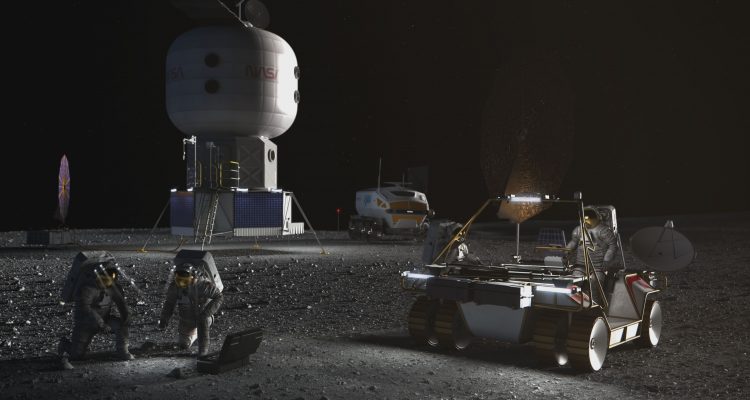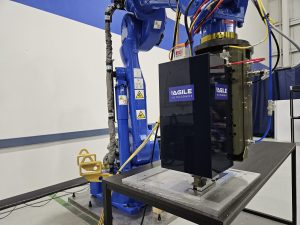Strong Enough for Space
A NASA research team investigating methods of welding thermoplastic components could be opening up opportunities on the moon and in deep space for the composites industry.
The Thermoplastics Development for Exploration Applications (TDEA) team is funded through NASA’s Game Changing Development program. Researchers previously developed a bonding process for thermosets that will be used on the space agency’s new Space Launch System (SLS). Now they are looking into welding processes that could eliminate the need for heavy bolts typically used to join composite components. Potential applications include missions like the Roman Space Telescope (RST), which is an infrared telescope focused on studying dark energy, and the Tall Lunar Tower (TLT), a concept for elevating solar panels above the horizon to generate energy on the moon.
While the TDEA project is separate from the RST and TLT programs, the team has identified these structures as amenable to thermoplastic welding and established point designs based off the baseline designs and structural requirements of those programs.
The welding project, which began in 2021, has multiple components. The first step was reaching out to the composites industry, academia and other research organizations to determine state-of-the-art practices in thermoplastics manufacturing and analysis. Researchers next evaluated five materials for their crystallization kinetics, including melting and crystallization temperatures, latent heat of crystallization and thermal conductivity relevant to welding.
Using all five materials, the team welded thermoplastic coupons using induction, resistance and ultrasonic techniques. “We evaluated their limitations with respect to materials and to the process,” says Sandi Miller, chemical engineer at NASA’s Glenn Research Center in Cleveland. The team also considered how easily each welding process could be used for in-space manufacturing processes. Induction welding, for example, might not be a viable choice since it requires auxiliary equipment for cooling.
NASA worked with three organizations – one for each type of welding – with an emphasis on the ultrasonic welding process from Agile Ultrasonics due to its promise of in-space operation. As of late May, researchers were trying to optimize that process to reduce void content.
“We have looked at process variables such as amplitude, pressure and dwell time, as well as the scan rate across the bond line,” says Miller. To reduce void formation in the bond region, they will also experiment with an energy director, which is placed at the interface of the bond and pulls the ultrasonic energy to the interface.
TDEA researchers are working simultaneously on two test applications. The Thermoplastic Terrestrial Point Design (TTPD) is adapted from the RST team’s design of a support beam assembly used to hold the telescope’s deployable aperture cover (DAC) blanket. The DAC closes over the telescope barrel during launch and then opens in orbit to help block sunlight from entering the aperture.
In the TDEA’s proposed design, the collar and beam assembly that helps open the DAC would become a single welded thermoplastic assembly, with the beam made from Toray’s Cetex® TC1200 PEEK and an additively manufactured carbon fiber reinforced PEEK with 30% fiber content for the collar area. This reduces the complexity, the part count and the mass of the assembly, according to William Mulhearn, aerospace materials engineer at NASA’s Goddard Space Flight Center in Greenbelt, Md.
The TDEA design for the TLT is known as the Thermoplastic In-Space Point Design (TSPD). The 50-meter tower, which might eventually be erected at the lunar South Pole, is intended to support solar arrays that will provide the United States’ moon base with power. Under the existing design, robots will connect the tower’s composite truss structure using metallic fittings and rivets. The TDEA team would like to improve upon that.
“We could make these truss structures out of thermoplastics and then have robots weld them through an end fitting. We would save all the weight of the rivets and also the management of the individual bolts,” Miller says. To test the feasibility of this approach, the researchers are building a small section of tower, which they call a repeating unit cell, with T700 carbon fiber and Cetex TC1225 low-melt PAEK from Toray. They will run tension and compression tests on the welded joints in that cell.
The TDEA team plans to have the testing data for both point designs completed by the end of the government’s fiscal year on Sept. 30, 2024, but they hope to get additional funding to continue this work.
“There’s still quite a bit to do. We are trying to demonstrate the welding process in a vacuum chamber at cold temperatures, and we have plans to weld with a lunar dust simulant at the bond line,” Miller says. “There are also many unknowns when we’re trying to ultrasonically weld a large structure. For example, does the vibration from each subsequent weld affect the integrity of the previous weld? All the data that we collect will be useful in moving this work forward.”
Miller says thermoplastic composites could unlock other application possibilities – and potential research projects – for NASA, including high-rate manufacturing, in-situ consolidation and electric propulsion for aeronautics, as well as long-term cryogen storage on the lunar surface.
“Because thermoplastics are relatively easy to manufacture, they’re opening up this new space of investigation for different applications,” she adds. “There’s a lot of work that’s been done on thermoplastics, but I think there’s still a lot more that can be done.”
Mary Lou Jay is a freelance writer based in Timonium, Md. Email comments to mljay@comcast.net.
NASA’s Thermoplastics Development for Exploration Applications (TDEA) team conducts research using Agile Ultrasonics’ welding system with a robotic end effector.
Photo Credit: Agile Ultrasonics Corp.



